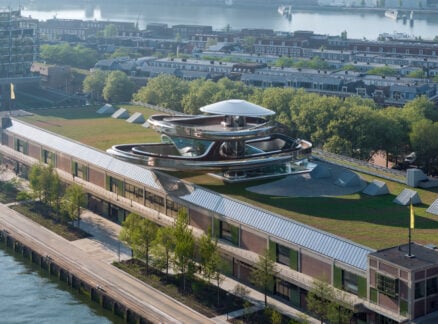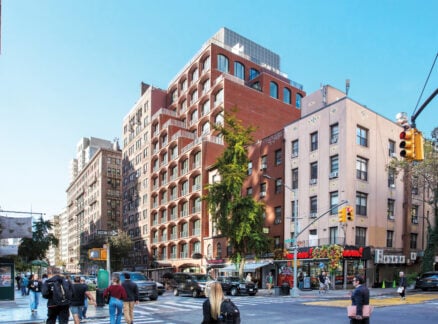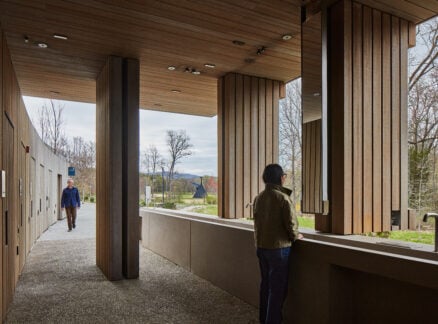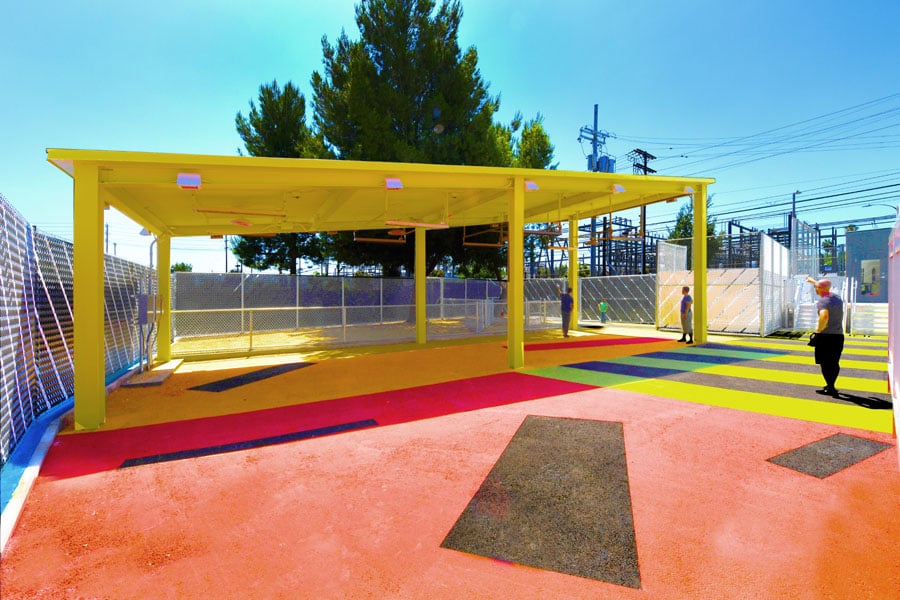
September 24, 2020
A Temporary Shelter Addresses L.A.’s Homeless Crisis Through Surface and Color
Lehrer Architects designed the Aetna Street Bridge Home on a tight timeline and budget while centering values of dignity that’s deep-rooted in the firm’s practice.
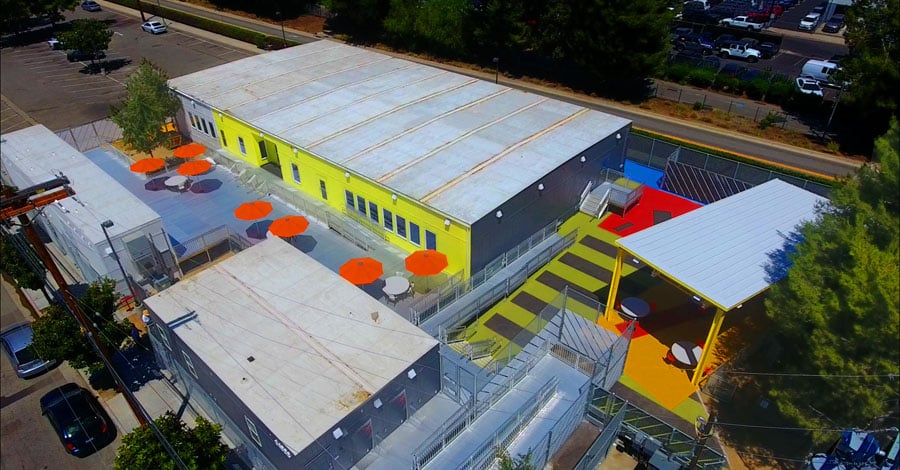
When discussing Los Angeles’s acute housing and homeless crisis with architect Michael Lehrer, any hint of technocratic myopia gets immediately jettisoned from the conversation. “What is more important and more noble than creating a place for people who have lived on the street, who have had the worst indignities?” posits the L.A. native and founding partner of Silver Lake–based Lehrer Architects. “Beauty is a rudiment of human dignity. I believe that so fundamentally,” he emphatically states.
It’s a philosophy put into practice at places like the Aetna Street Bridge Home temporary shelter that opened this past summer. Since Lehrer designed the Downtown Homeless Drop-In Center for the Los Angeles Homeless Services Authority over 20 years ago (located in the heart of L.A.’s Skid Row), serving unhoused and vulnerable populations has been a personal and professional mission—and an increasingly significant part of his firm’s output.
Lehrer, who received the AIALA Gold Medal in July and is married to landscape architect Mia Lehrer, is a longtime board member of the nonprofit organization Homeless Health Care Los Angeles. His ideals about architecture’s power to remedy social ills isn’t Pollyannaish; instead, it’s informed by decades of grappling with public policy, economic, and cultural realities.
Lehrer Architects has become more deeply involved in the affordable housing sector in recent years. The company formed a partnership with nonprofit developer Restore Neighborhoods Los Angeles, community funder Genesis LA, Supportive Services Group, and general contractor Curtom-Dunsmuir under the Rethink Housing LA development banner. This entity specializes in by-right, cost-effective, design-forward solutions to build multifamily housing on small lots in South Los Angeles.

In the shorter term, Lehrer and partner Nerin Kadribegovic were awarded and completed the Aetna Street Bridge Home as part of the fast-tracked A Bridge Home program. (The initiative launched in 2018 and is designed to target each of the city’s 15 council districts; it has faced various bureaucratic delays and NIMBY opposition, as well as criticism from homeless advocates.)
The Aetna Street Bridge Home is located on a quarter-acre parking lot adjacent to the Orange rapid bus line in the Van Nuys neighborhood of the San Fernando Valley. Despite the powers-that-be’s commitment to streamlining the approval process, the undertaking required nimble maneuvering of L.A.’s notoriously thorny regulatory landscape. The design was delivered early and below the projected cost late last year, with plans and permitting completed in under four weeks. Construction lasted approximately four months. In addition to the tight timeline and budget, its constraints encompassed the question of “how you do take ordinary elements and make them extraordinary?” Kadribegovic explains.
The temporary shelter comprises 70 beds and 23 trailers. The outdoor spaces include an area for pets shaded by existing trees and also includes a canopied dining and social area, safe storage for clients’ belongings, an intake/administration section, and hygiene trailers. (Most other Bridge Home sites have used Sprung structures, or in the case of one in the Hollywood area, a midcentury library was adapted into a shelter.)
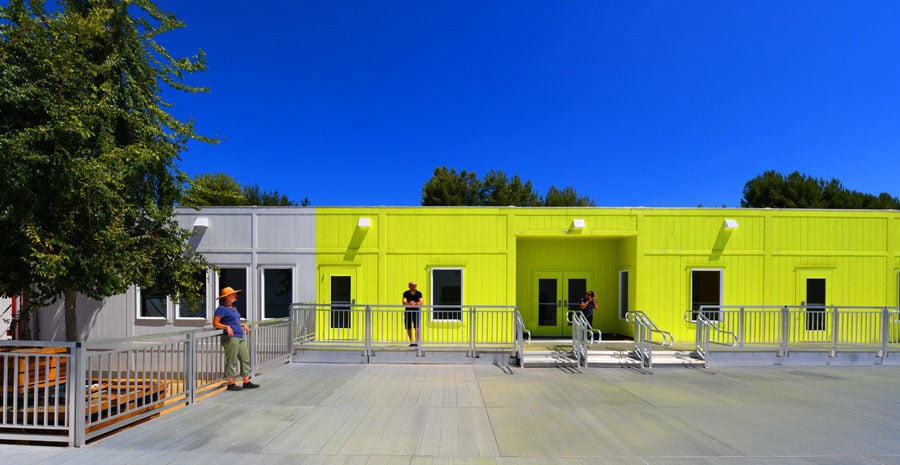
The designers leaned into paint and color as a nearly cost-neutral tool that’s served them well in the past. “The powerful thing is just by painting it one color, it became a placemaking and space-shaping volume,” Lehrer says about the chromatically saturated exterior components. Instead of using neutral brown and beige tones typically used for mundane modular trailers, bold shades of yellow, orange, green, and blue were applied to the structures, as well as on the ground to differentiate uses. “Every surface matters in design,” Lehrer notes. “The ground plane is incredibly important.”
These details tie into a broader objective. Regardless of socioeconomic status, “I’m a made man if someone comes to a place that I and my colleagues designed, takes a deep breath, and says, ‘I’m happy to be alive because I am here,'” Lehrer says. “That is the work. That is the mission.” Hopefully clients at the Aetna Street Bridge Home access this feeling as a stop along the journey to the ultimate goal: finding a permanent, supportive home.
You may also enjoy “70 Rainey in Austin is a Park in the Sky.”
Would you like to comment on this article? Send your thoughts to: [email protected]
Register here for Metropolis Webinars
Connect with experts and design leaders on the most important conversations of the day.



















